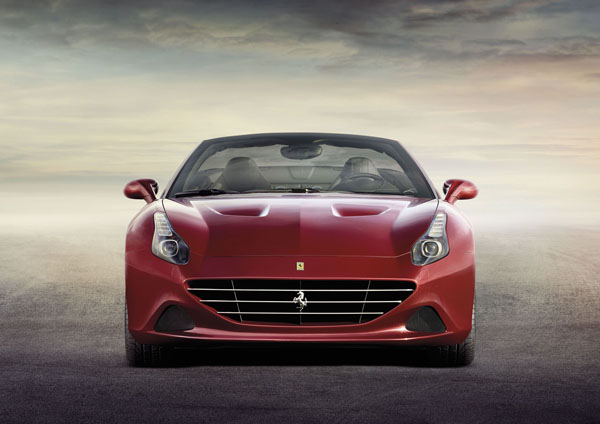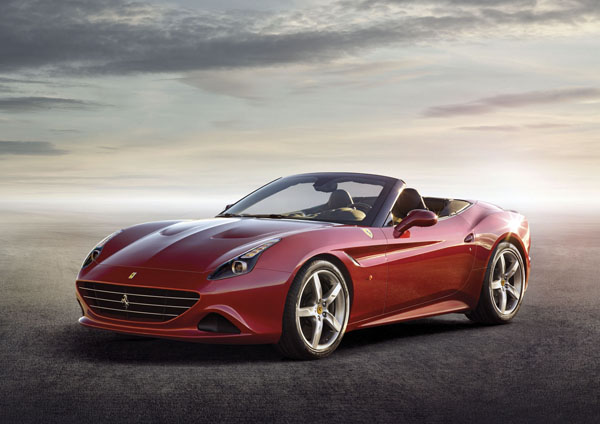What better way to celebrate the first anniversary of the announcement of the California T than to spend a sunny weekend in one? We couldn’t think of a better way either, so settled for just that.
It gave us the chance to see what Maranello has done to address the complaints about the first car while also previewing what’s in store for the future – forced induction V8s are going to be a big part of the coming models, the 488 GTB in particular.
VALUE
Yes, well. There’s no getting away with it, this is a small apartment’s worth of car, with the ability to upgrade to a two-bedroom apartment if you cut loose in the options. It’s obvious that anyone with this kind of money to spend isn’t super-bothered by the dangers of personalisation, so getting upset about option prices is as useful or relevant as telling someone under twenty to have a Bex and a good lie down.
The basic price is $409,888. This buys you that prancing horse badge, dual-zone climate-control, beautiful leather interior, remote locking, cruise control, auto-folding heated rear vision mirrors, 19-inch alloy wheels, 6.5-inch screen with DAB radio, sat-nav, front and rear parking sensors, auto wipers and headlights and you even get a car cover thrown in.
There was a huge range of options added to the test car, bringing the total to $549,387. Highlights were the stunning California Rosso paint ($20,500), Ferrari shields on the bodywork ($3000), magneride suspension ($8970), carbon fibre steering wheel with LEDs ($12,500) and Apple CarPlay ($6790).
DESIGN
The new California is a far more Ferrari-looking car than the first attempt. Front and rear look like they belong together and there’s a more tapered posterior.
The interior has had an update too, with a new screen and various bits and pieces.
Our test car had a number of optional carbon fibre trim pieces including the central bridge that houses three control buttons (launch, auto mode and reverse), custom stitching and alcantara trim. While the interior colour may not have been to everyone’s taste – or the carbon fibre pieces – the quality is unmatched.
The twenty-inch wheels ($10,050) also gave the car an even lower-looking stance. The California loves big wheels.
SAFETY
There’s no ANCAP rating, but the California has four airbags, ABS, traction and stability control.
INFOTAINMENT
Our California T had Apple’s CarPlay fitted. If you’re in possession of one of Cupertino’s finest, plug in via the dedicated USB hidden in the console and ensure your phone is unlocked. The onboard screen displays the apps that are compatible with the systems, such as Google Maps and Spotify. The car will read your texts to you and allow you to reply with Siri. It makes finding your music much more like the phone, too, with a simple touch interface to find what you’re looking for.
Naturally, there’s Bluetooth and standard USB for other devices, with good call quality even with the hardtop stowed.
ENGINE / TRANSMISSION
The V8 is now twin-turbo powered. This is obviously big news for a lot of reasons – it’s the first Ferrari road car since the F40 to have forced induction and is a preview of what’s to come for the 488 GTB.
The 3855 cc V8 gets a flat-plane crank and three piece exhaust to help combat the sound-deadening of two turbos.
Power and torque are up to 412 kW (up 46 kW) and a quite staggering 755 Nm torque.
The seven-speed dual-clutch gearbox is familiar to Ferraristi and has had the requisite upgrades for the extra mumbo. Ferrari claims 10.5 litres per 100km on the combined cycle, but with our right foot, we saw much closer to 15 L/100km, which is still incredible going, really.
DRIVING
What sets the California apart from the 458 and F12 (except price, obviously), is the way you can just puddle about without raising your or your passengers’ heart rates. In comfort mode, the damping smooths out all but the deepest potholes and manholes and expansion joints are pleasantly muffled.
The steering, which is always light, cuts down on the chatter and can leave you wondering what all the fuss is about. Ferrari’s seven-speed dual-clutch is incredibly smooth through the shifts and all that’s left to remind you of the prancing horse (apart from all the logos in the cabin), is a blare from the exhaust.
The big differences really are behind the wheel in the T – the old car felt soft (for a Ferrari) in the front end and the naturally-aspirated V8, while a bellowing monster, wasn’t quite right for the character of the car. It felt compromised and a bit heavy. Ferrari has knocked those problems clean off.
Switch the three-stage Manettino to Sport or ESC off, and the California wakes up. The steering subtly firms up, the gearbox readies for action and all the assorted electronics are ready for war.
Send the throttle towards the firewall and while there’s a brief moment of, “Where’s the…”, interrupted by an eruption of torque accompanied by a magnificent turbo inhalation. The flat blare from the exhaust becomes a roar and with barely a wriggle you’re on your way to 100 km/h in 3.6 seconds, terrifyingly close to the 458’s figure.
The shift from first to second is accompanied by a colossal whip crack and you’re tearing through the revs again to the 7500 cutout. Another pull on the right paddle and well past Australian speed limits anywhere but the Northern Territory and you’re on your way to a glorious if inconvenient removal of your right to drive and, if you keep going into fourth, your general liberty.
As the first corner comes at you at speeds you probably wouldn’t have been able to contemplate in the old car, you turn the wheel in the desired direction. There’s an initial hesitation – you have to remind yourself to turn the wheel a little further in the Cali – and the front end starts to bite.
The magic happens in the F1-Trac diff. It really does feel like magic, and to explain it would take far too long. A car with all this torque shouldn’t be so easy to control without all the nannies turned up to full McPhee. But it is. Turn this stuff off in an F12 and if you’re anything other than track-trained, you’re stuffed. Into a wall or tree, usually.
Finally, the carbon ceramic brakes. These things have come a long, long way over the years, almost to the point that the California’s feel like a fantastic set of steels but with the stopping power of a race car’s. The initial bite, even when cold, takes some getting used to but what will stick in your mind is the way they work when you’re really moving. Progressive and with a firm pedal, the big perforated alloy plate under your foot is nearly as good a party trick as the accelerator.
Stamp on the pedal and you feel like the rear end is lifting from the road as the huge calipers grasp the 390 mm front and 360 mm rear discs. It’s tremendous fun to stamp on the brakes and bring the car to a halt from 100 km/h in just 34 metres. The 245 front tyres and 285 rears ensure it will do it time and again.
SUMMING UP 4.5/5
In this job, you have to remember that driving a Ferrari for a weekend is not the same as owning one. Overcoming the mystique of the badge isn’t easy, especially when you realise just how much better the T is over the old car.
Notions of value-for-money are pointless, so addressing them doesn’t do the car justice, so let’s view it in context.
The California T is the Ferrari that you could live with. It causes a bit of a stir but not so much it will make you paranoid. It’s comfortable, can fit shorter humans in the back with a bit of shuffling and is delightfully, deliriously, fun to drive.
LIKES: Torque, torque and more torque
DISLIKES: Still a bit awkward-looking at the rear












